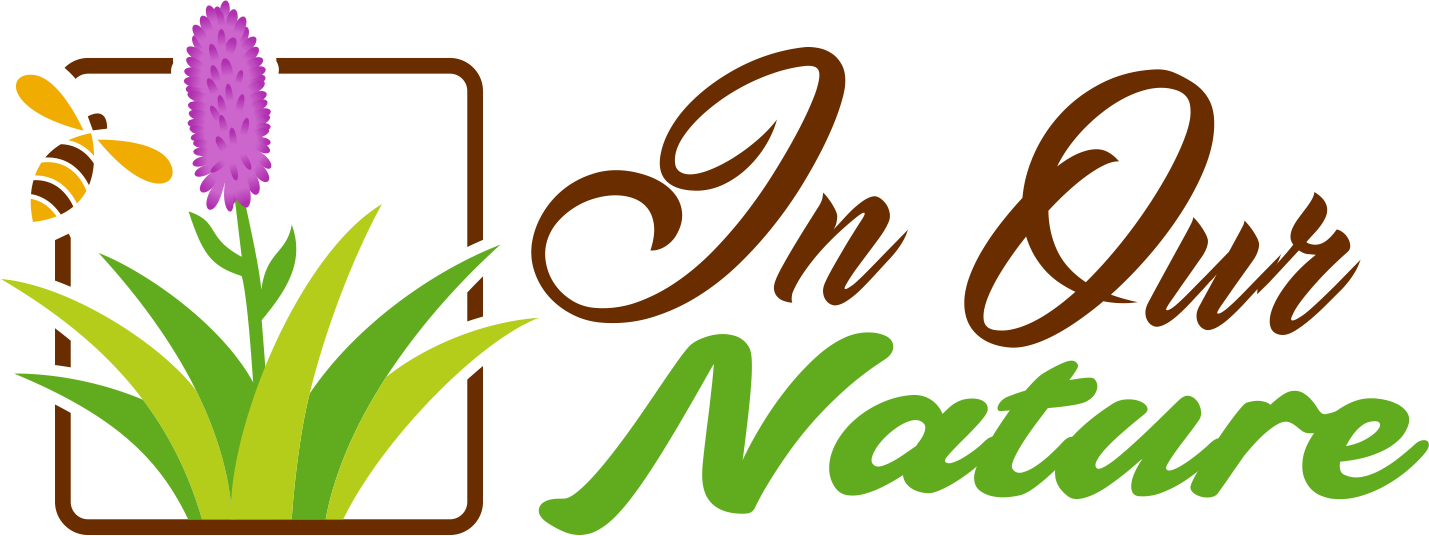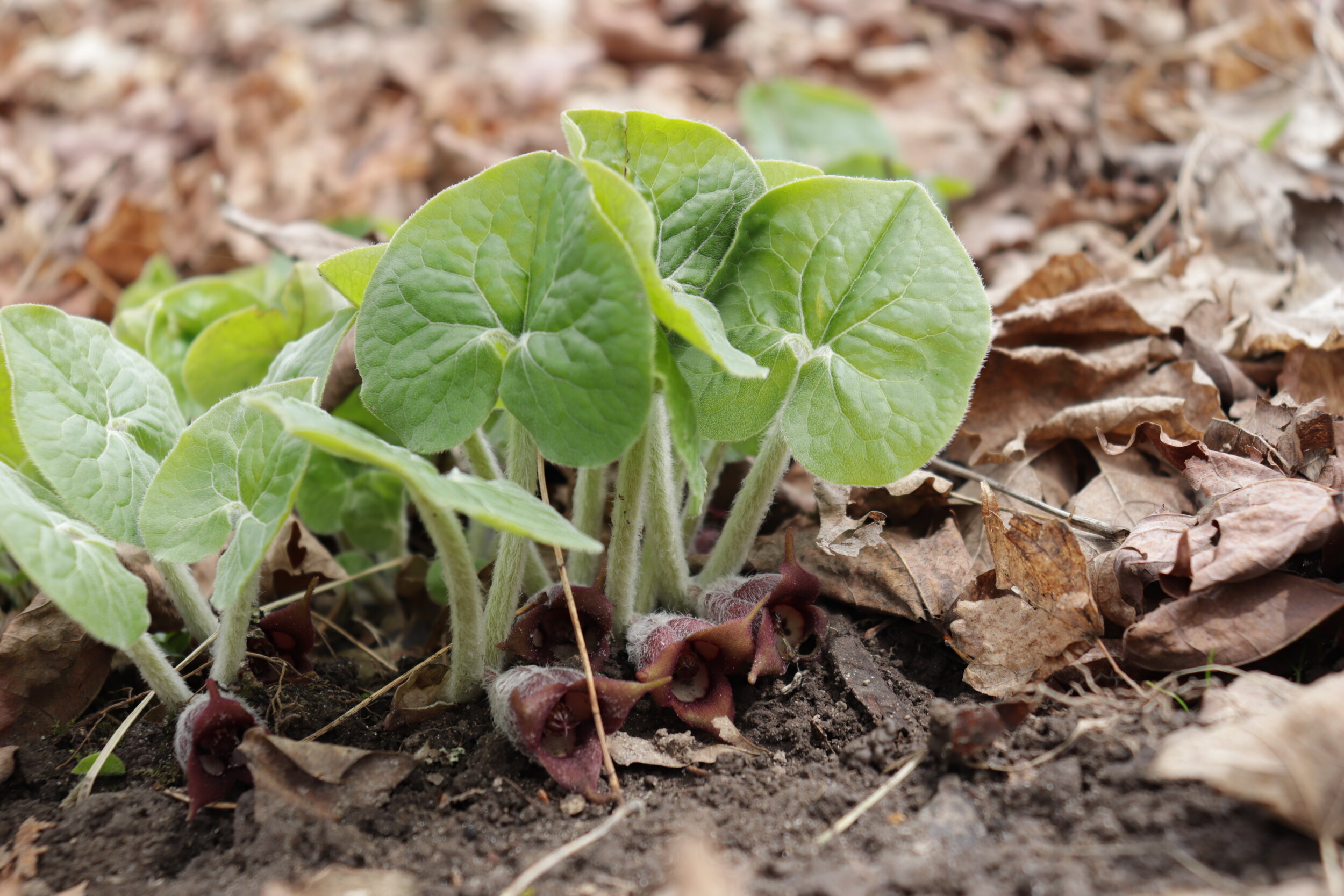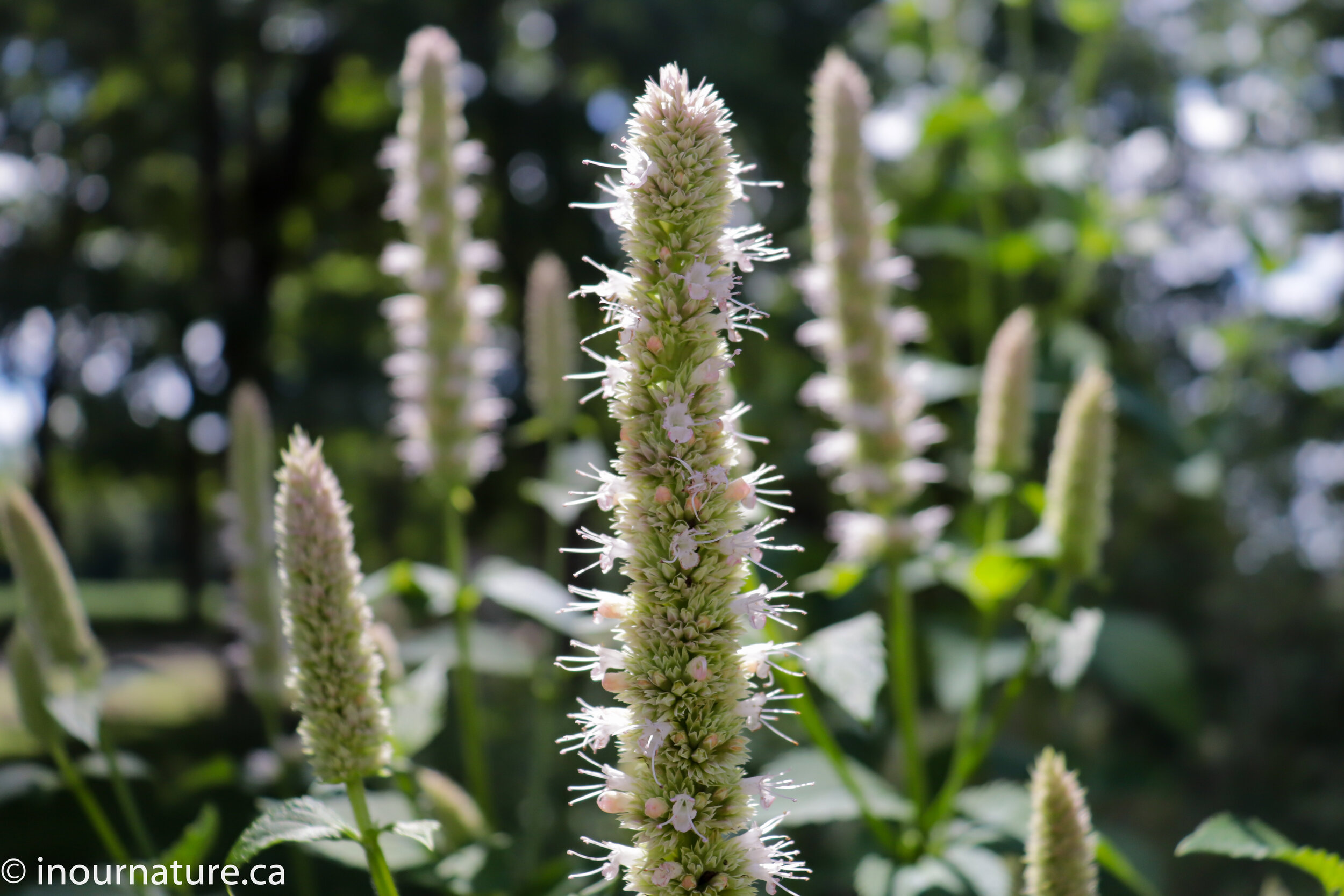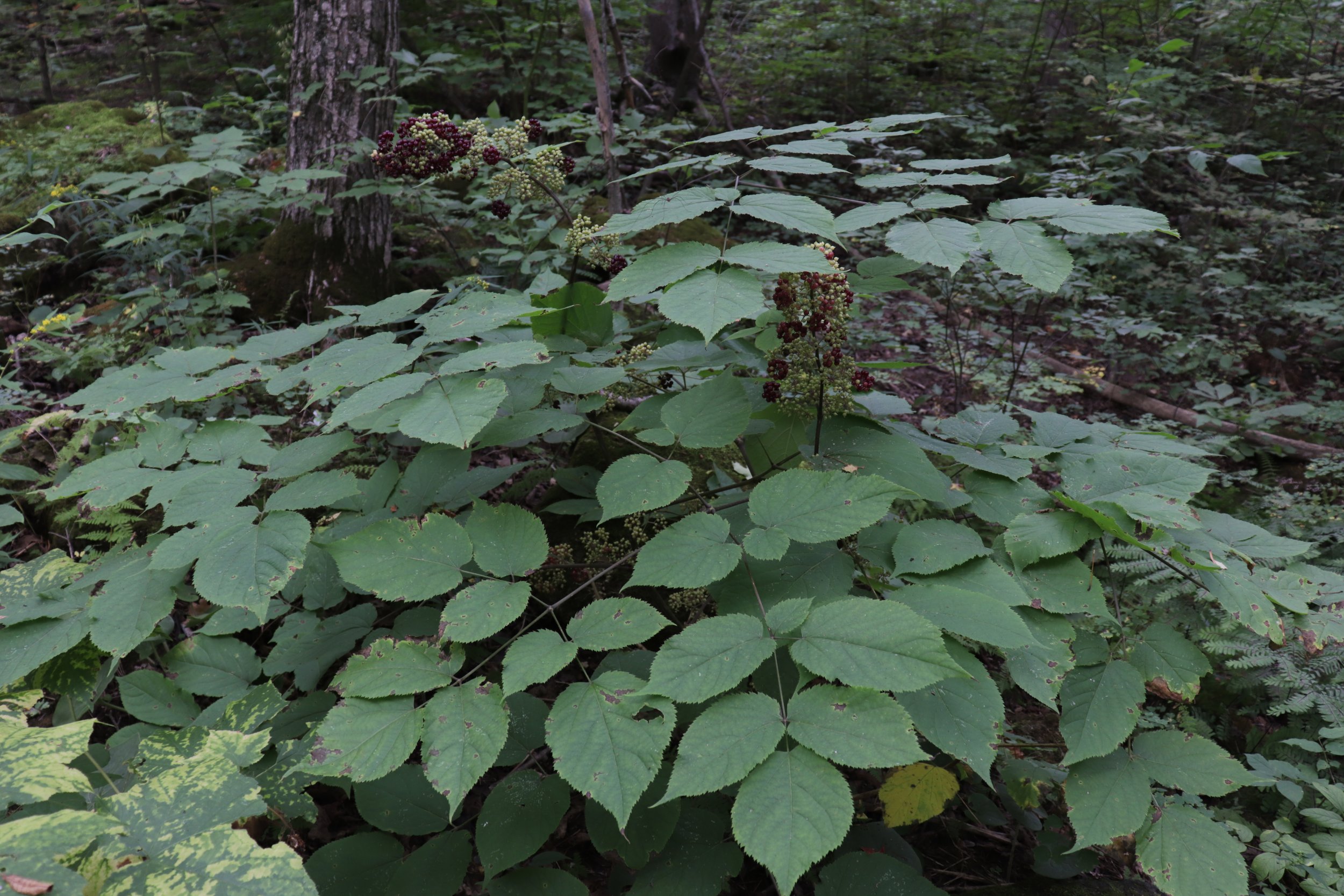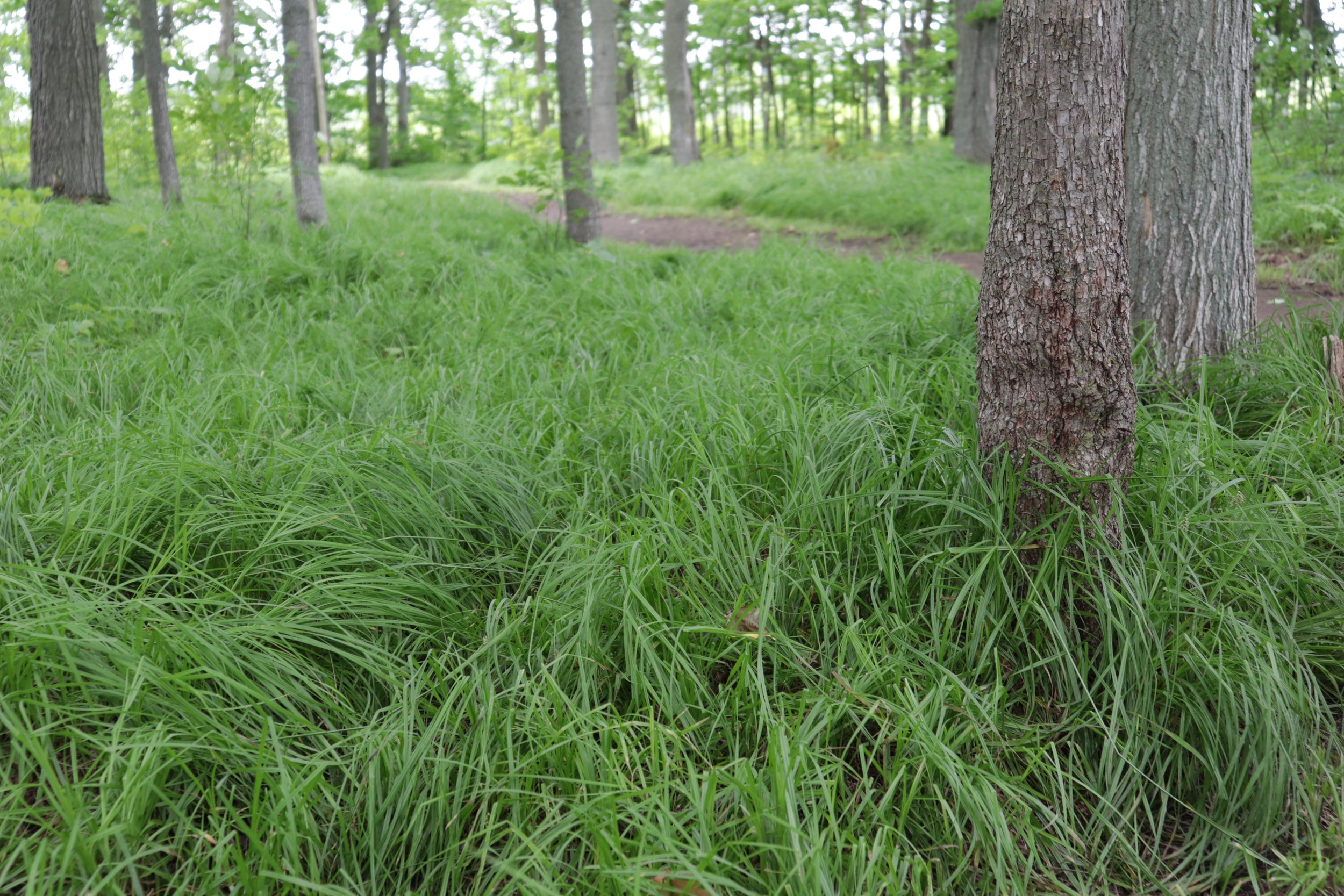Ontario Native Plants For Shade
| Yes, you can have a pollinator garden in the shade! |
Gardeners don’t have to resort to unimaginative masses of over-used, exotic foliage plants like Hostas or Astilbes to garden is the shade.
In fact, many traditional shade plants are known invasive species such as Periwinkle, Pachysandra, Creeping Jennie and Goutweed. In reality there is no reason to use these plants when we have such a diversity of pollinator-friendly native shade plants to choose from in Ontario. Click here to learn more about native alternatives to these invasive species.
Southern Ontario once supported vast forest ecosystems with a high diversity of shade-tolerant native species that adapted to thrive in shady conditions, many of which are available to plant in your garden!
What type of shade do you have?
Dappled shade from deciduous trees is the ideal growing condition for most native shade plants.
Not all shade is the same so, before choosing plants, use this quick reference to understand what type of shade you have:
Part shade - 4-6 hours of morning sun or evening sun. No (or very little) harsh mid-day sun. Typically these are the plants you’d find growing along forest edges, clearings or trail-sides.
Dappled shade - The kind of shade you’d see while walking through a deciduous forest where spots of sunlight trickle through the canopy. For reference purposes, lawn grass still grows well here but is more sparse than in full sun.
Deep shade - Shade from a house, evergreen trees or under a Norway Maple (they are deciduous but their canopy is very dense) where little direct sun ever touches the ground. For reference purposes, lawn grass will not grow here.
Deciduous shade - This applies mainly to spring ephemerals who need nearly full sun in the spring before trees leaf out, then dappled shade for the rest of the summer or until they go dormant. They typically wouldn’t do well in full, year-round shade.
Dry shade - For dry shade read this article.
Table of Contents
There are too many shade tolerant native plants to list here but these are some of my favorites based on commercial availability, wildlife value, beauty and how easy they are to grow. Many can be found at our online native plant nursery.
Spring
Shrubs/Trees
Shrubs are valuable for adding structure and nesting opportunities for birds in your garden. By layering plantings with plants of varying heights, you can increase the amount of wildlife value in your space.
Alternate-leaf Dogwood (Cornus alternifolia)
Height: 7.6m, 25ft
Blooms: White, spring
Soil conditions: Organically rich, well-draining soils. Adaptable.
Exposure: Part shade, dappled shade.
Alternate-leaf Dogwood ( a.k.a Pagoda Dogwood), is a small tree with an attractive, layered look to it’s branches. It is a true understory tree, meaning it thrives in the shade of large trees however, it will tolerate part sun.
The early spring flowers are showy and attract a diversity of native pollinators. They give-way to dark blue fruit borne on red stalks.
The berries of Pagoda Dogwood don’t last long because they are a favourite food source of birds. You can expect to see a wide-variety of fruit-eating birds such as Cedar Waxwings, Catbirds, Juncos and Cardinals.
Bush Honeysuckle (Diervilla lonicera)
Height: 90cm, 3ft
Blooms: Yellow, summer
Soil conditions: Dry to average, well drained soils. Grows in shallow/rocky soils.
Exposure: Part shade, dappled shade, dry shade
Bush Honeysuckle is an adaptable, low growing shrub often found growing along forest edges, trail-sides and open woods.
The suckering nature of this shrub makes it useful for massing and covering large areas.
Yellow, trumpet-like flowers bloom from late spring well into summer. The fall foliage is an incredible red/maroon colour.
The flowers provide an excellent source of nectar for bumblebees and Ruby-throated hummingbirds. Bush Honeysuckle is the larval host for the Fawn Sphinx moth (Sphinx kalmiae). Its beauty and adaptability means it will quickly become a favorite in your garden.
Spicebush (Lindera benzoin)
Height: 3.6m, 12ft
Blooms: Yellow, early spring
Soil conditions: Moist, well-drained, organically rich soils.
Exposure: Part sun, dappled shade
Spicebush is a fragrant native shrub, often found growing in moist, deciduous forests and low, shaded areas.
Clusters of fragrant, yellow flowers bloom early in the spring, before the leaves have even emerged and support various native bees and butterflies.
On female plants, the flowers will give way to bright red fruits that mature in the fall months. The berries look great against the attractive yellow fall foliage, giving Spicebush great fall interest in the garden.
These red fruits don’t last very long before birds eat them up! American Robins, Catbirds, Wood Thrush and Great-crested Flycatchers will flock to the fruits.
All parts of Spicebush are edible for humans too.
Flowering Raspberry (Rubus odoratus)
Height: 1.8m, 6ft
Blooms: Pink with yellow centers, summer
Soil conditions: Moist to average, well-drained soils. Tolerates drought and shallow soil.
Exposure: Full sun, part shade, dappled shade
Purple Flowering Raspberry is an understory shrub often found in forests, forest edges and shady slopes. It is a very adaptable shrub and will grow well in a wide variety of conditions including rocky soil and dry, deciduous shade.
Purple Flowering Raspberry is a suckering shrub but is not an aggressive spreader in shady areas (plant it in the sun and it spreads quite fast!). Use it as an understory shrub and structural plant in your woodland garden.
The mid-summer flowers support a diversity of native pollinators including Bumblebees.
Red Elder (Sambucus racemosa)
Height: 3.6m, 12ft
Blooms: White, spring
Soil conditions: Moist, well-drained soils. Prefers rich, organic soils. Tolerates shallow, rocky soils.
Exposure: Part shade, dappled shade
Red Elder is a common shrub in forests where it thrives where there are openings and gaps in the canopy. It is valued in gardens for it’s shade tolerance and attractive lacy foliage.
The showy clusters of white flowers are valuable for a variety of early season bees.
The flowers give-way to vibrant red berries in summer. The berries are quickly eaten by birds such as Cedar Waxwings.
The hollow stems provide nesting opportunities to solitary bees.
Bladdernut (Staphlea trifolia)
Height: 4.5m, 15ft
Blooms: White, spring
Soil conditions: Prefers moist, well-drained soils with abundant organic matter. Tolerates drought once established.
Exposure: Part sun, dappled shade
Bladdernut is a fast-growing small tree usually found in woodlands, thickets and shaded streamsides. It’s often found in woodlots with Sugar Maples and Basswood.
Drooping clusters of white, bell-shaped flowers provide pollen and nectar for mining bees, sweat bees and bumblebees.
The dried seed pods hang onto the branches and add interest to the winter garden.
Spring Blooms
When it comes to shade tolerant native plants, spring blooms are abundant! Some of the following plants will die back after flowering but many will retain their leaves for the rest of the growing season. Keep this in mind when planning your garden. An abundance of spring blooms will set pollinators up for a successful season.
Canada Ginger (Asarum canadense)
Height: 30cm,1ft
Blooms: Burgundy
Soil conditions: Prefers moist, rich soils but will tolerate dry shade.
Exposure: Dappled shade, deep shade
A classic native groundcover for shade gardens! Wild Ginger shows off lush, heart-shaped leaves and unique, burgundy flowers that rest on the ground.
Wild Ginger spreads slowly but steadily to form colonies, even on slopes. It pairs very well with the finer textures of sedges and ferns. The leaves stay green until the fall.
Tolerates dry shade and is deer resistant. Very low maintenance.
Running Strawberry Bush (Euonymus obovatus)
Height: 30cm, 1ft
Blooms: Green
Soil conditions: Moist to slightly dry, well-draining, loamy or rocky soil.
Exposure: Dappled shade
Running Strawberry Bush is an under-used groundcover with a low, trailing habit.
The green flowers are not much to look at, however, the real attraction is the spiky, pink seed pods. As they mature, bright red seeds are revealed, adding dots of red to the late summer garden. In addition, the foliage turns beautiful shades of red in the fall.
It spreads quickly but not aggressively so feel free to plant it with other woodland species.
Spotted Geranium (Geranium maculatum)
Height: 60cm, 2ft
Blooms: Purple
Soil conditions: Prefers moist, well-drained, organic rich soils but tolerates drier conditions once established.
Exposure: Full sun to dappled shade
Spotted Geranium is a showy woodland plant with light purple flowers. It is a pollinator magnet while in bloom!
Even once the spring blooms fade, it retains a lush mound of leaves well into fall where it turns a vibrant shade of red.
The flowers provide nectar and pollen to bumblebees, mason bees, cuckoo bees, sweat bees, Syrphid flies and skippers.
Native bees can be found sleeping in the flowers at night.
Virginia Waterleaf (Hydrophyllum virginianum)
Height: 60cm, 2ft
Blooms: White to lavender
Soil conditions: Moist to slightly dry, well drained soil. Prefers soils rich in organic matter.
Exposure: Part shade, dappled shade
Virginia Waterleaf is very early to leaf-out in the spring. The early spring leaves look as if they have been stained by water, hence the common name “waterleaf”.
It shows off with clusters of bell-shaped flowers that range in colour from white to lavender. These flowers are usually buzzing with bees especially bumblebees, mining bees, mason bees and sweat bees.
Virginia Waterleaf spreads quickly by seeds so its a suitable groundcover for shady areas.
Virginia Bluebells (Mertensia virginica)
Height: 60cm, 2ft
Blooms: Pink, purple, blue
Soil conditions: Average to moist, well-drained soils. Does best in organically rich soil.
Exposure: Deciduous shade
Virginia Bluebells are true spring ephemerals meaning they put on a dazzling display of blooms in early spring then go dormant by the mid-summer heat.
Therefore, they are best planted with something that can fill in the space when they are done, such as Oak Sedge.
The early flower buds start out pink, turn to purple as they open then change to blue for the remainder of their blooming period. This native plant is absolutely stunning to see on mass!
The tubular flowers are especially valuable to bumblebees, mason bees and other long-tongued bees. Butterflies, skippers, Sphinx-moths and even Ruby-Throated hummingbirds will benefit from the flowers too.
Woodland Phlox (Phlox divaricata)
Height: 30cm, 1ft
Blooms: Purple to pink to white
Soil conditions: Humusy, average moisture, well-drained soils. Prefers rich organic soil.
Exposure: Part shade, dappled shade.
A native phlox! Woodland Phlox is a low growing, sprawling phlox with fragrant spring flowers.
The semi-evergreen leaves stay lush and green long after the flowers fade so you can use it as a groundcover too.
It spreads by rooting wherever it’s stems touch the ground but I don’t think anyone will complain if this one spreads!
The long, tubular flowers are accessible by long-tongued bees (such as bumblebees), bee flies, butterflies and moths (especially sphinx moths).
Bloodroot (Sanguinaria canadensis)
Height: < 30cm, 1ft
Blooms: White with yellow centers
Soil conditions: Moist to average, well-drained, humus-rich soil.
Exposure: Part shade, dappled shade
The pure-white flowers of Bloodroot wake up to the world in early spring before it’s leaves have even unfurled. They don’t have a long bloom time (a few days) but they make up for it in unmatched beauty.
Once the flowers fade, the foliage will remain lush and green well into late summer granted the soil isn’t too dry.
The flowers don’t produce nectar, but supply ample pollen to bumblebees, carpenter bees, sweat bees and andrenid bees.
Foamflower (Tiarella cordifolia)
Height: < 30cm, 1ft
Blooms: Creamy white
Soil conditions: Average, well-drained soil. Prefers organically rich soils that don’t dry out completely.
Exposure: Part shade, dappled shade
Foamflower is a low, semi-evergreen groundcover that spreads by stolons/runners to form a dense mat of leaves.
In spring, spires of creamy-white flowers rise above the leaves and act as a beacon to bumblebees, mining bees, small butterflies, beetles and flies (especially Syrphid flies).
The heart-shaped leaves are semi-evergreen and will stay green until covered by snow.
Large-flowered Bellwort (Uvularia grandiflora)
Height: 60cm, 2ft
Blooms: Yellow
Soil conditions: Average, well drained soils. Does best with a high organic content in the soil. Grows in rocky soils.
Exposure: Dappled shade, dry shade
Large-flowered Bellwort is a unique and showy spring wildflower. The droopy bell-like yellow flowers (and whole plant for that matter) have a wonderful twisted look to them.
The foliage sticks around until fall and adds a lush, bold texture to shade gardens.
They are a source of nectar and pollen for Bumblebees, mason bees, Halictid bees and Andrenid bees.
Summer Blooms
It can be hard to find summer blooms for shade gardens because most shade species bloom early in the year to make use of the extra light before trees leaf out. The following native plants typically bloom in early or late summer.
Black Cohosh (Actaea racemosa)
Height: 1.8m, 6ft
Blooms: Creamy white
Soil conditions: Average moisture in organically rich soils. Doesn’t like drying out.
Exposure: Part shade, dappled shade
Black Cohosh is an excellent native plant for adding structure and height to shade gardens.
In late summer, tall spires of fragrant white flowers rise above the astilbe-like foliage. These flowers are especially popular with bumblebees and sweat bees.
The seed heads persist to add excellent winter interest.
Black Cohosh is a slow grower but the wait is definitely worth it!
Giant Purple Hyssop (Agastache scrophulariifolia)
Height: 2.1m, 7ft
Blooms: Light pink
Soil conditions: Moist to average. Well drained. Prefers rich soil. Tolerates dry shade.
Exposure: Part shade, dry shade
Giant Purple Hyssop is a striking plant with a rigid, upright form. It's light-pink flowers are small but numerous and act as a beacon, calling in pollinators from far and wide.
These long-blooming flowers are an excellent nectar source for native bees and butterflies.
The rigid stems provide interest well into winter months.
Hollow stems provide nesting opportunities for solitary bees.
Tall Thimbleweed (Anemone virginiana)
Height: 60cm, 2ft
Blooms: White
Soil conditions: Dry to average, well-drained soil. Prefers moist, organically rich soil.
Exposure: Full sun, Part shade, dappled shade
Tall Thimbleweed is an upright, clumping native anemone with broad, deeply lobed leaves.
The small, white blooms reach for the sky in late spring/early summer and look great when massed.
The flowers support small native bees such as Sweat Bees, and flies such as Syrphid (Hover) flies.
The thimble-like seed heads persist into winter and puff out when they are ripe. Excellent winter garden interest.
American Spikenard (Aralia racemosa)
Height: 1.5m, 5ft
Blooms: Creamy-white
Soil conditions: Organically rich, well draining soils with average moisture.
Exposure: Part shade, dappled shade
Spikenard is a showy, shrub-like perennial with bold leaves. It gives the appearance of a shrub but it is a perennial and the top-growth will die back to the ground every winter.
Clusters of small, creamy-white flowers bloom in early to mid summer and are an important food source for pollinators. By fall, the flowers have turned into clusters of small, red/purple berries that glisten as the sun catches them.
The fruits are eaten by songbirds, Turkey and Grouse.
Poke Milkweed (Asclepias exaltata)
Height:1.5m, 5ft
Blooms: White
Soil conditions: Well-drained, organically rich soil.
Exposure: Part shade, dappled shade, dry shade
Poke Milkweed is a unique milkweed species because, where most Milkweeds need lots of sun, this one thrives in the shady conditions of forest floors and forest edges.
The large, oval leaves and tall stature of Poke Milkweed make it an excellent structural plant in shady gardens.
In summer, droopy clusters of white flowers are presented at the end of it’s slender stalks. The flower clusters are reminiscent of Common Milkweeds but are more sparse.
Larval host for Monarch butterflies and an excellent nectar source for pollinators of all kinds.
Woodland Sunflower (Helianthus divaricatus)
Height: 1.8m, 6ft
Blooms: Yellow
Soil conditions: Dry to average soils. Drought tolerant. Adaptable.
Exposure: full sun to Part shade
Woodland Sunflower is a prolific bloomer with a very sturdy, upright form. It prefers full sun but grows quite well in part shade but with reduced flowering.
It makes an excellent structural plant as it holds its form well into the winter months to provide year-round garden interest.
The seeds provide a buffet for birds and the flowers are popular with long-horned bees, bumblebees and butterflies.
Fall Blooms
Fall is a time for Goldenrods and Asters to shine and your shade garden should be no different! Fall is a crucial time for pollinators as they migrate or prepare to hunker down for the winter so don’t be afraid to go overboard with these showy fall blooming native plants!
White Snakeroot (Ageratina altissima)
Height: 90cm, 3ft
Blooms: White
Soil conditions: Consistently moist, well-drained soils. Adaptable.
Exposure: Part shade, dappled shade
White Snakeroot is an adaptable, fast growing shade plant that shows off with clusters of bright pure-white flowers.
The late-summer flowers are highly attractive to Sweat bees, Bumblebees and some butterflies.
It spreads quickly by seed to fill in open areas and bare soil. This makes it especially valuable for covering large areas and for restoration.
The seed heads often remain upright into winter months.
Note: White Snakeroot is toxic if ingested.
White Wood Aster (Eurybia divaricata)
Height: 75cm, 2.5ft
Blooms: White with yellow centers
Soil conditions: Dry to medium, well-drained soil.
Exposure: Part shade, dappled shade, dry shade
White Wood Aster features small but copious white flowers with yellow centers. These flowers really stand out in the shade.
It is a threatened species in Ontario, only being found naturally in a few locations.
White Wood Aster spreads by rhizomes and seeds, making it a great choice to cover larger spaces, even in dry shade! It can handle shallow rocky soil too.
Large-leaf Aster (Eurybia macrophylla)
Height: 30cm,1ft (leaves),90cm, 3ft (flower stalks)
Blooms: White to light purple
Soil conditions: Moist, well-drained soil. Tolerates dry soil with less vigor.
Exposure: Part shade, dappled shade, dry shade
Large-leaf Aster, known as migiziwibag by the Anishinaabe, is a valuable plant for shade gardens. It begins the growing season as an attractive ground cover(spreading via rhizomes) with rough, heart-shaped leaves.
Come late summer, early fall, flower stems will poke up from the leaves with open, flat topped clusters of white to light purple flowers.
Individual plants may not bloom every year so they are best planted en masse or as a groundcover.
Bluestem Goldenrod (Solidago caesia)
Height: 90cm, 3ft
Blooms: Yellow
Soil conditions: Dry to average, well-drained soils. Prefers rich soil but tolerates poor soil quite well.
Exposure: Dappled shade
Similar to Zigzag Goldenrod but with graceful, arching stems. The purple/blue stems and yellow flowers really come together for a striking, fireworks-like display.
Bluestem Goldenrod is very well-behaved, forming small colonies over time. It is primarily a clump-forming plant and self-seeds to a much lesser extent than Zigzag Goldenrod .
The flowers brighten up the shade and support many late season pollinators including native bees and butterflies.
Zigzag Goldenrod (Solidago flexicaulis)
Height: 90cm, 3ft
Blooms: Yellow
Soil conditions: Average to dry, well drained soils. Prefers rich soil but will grow in rocky/poor soil too.
Exposure: Dry shade, dappled shade
Goldenrods often get a bad reputation but I hope that Zigzag Goldenrod can help change your mind! This is one of the better behaved Goldenrods, spreading by seeds and to a lesser extent, rhizomes.
The yellow flowers light up the shade like no other while filling the air with a delightful floral fragrance.
Goldenrods are incredibly important in pollinator gardens because they are host plants for over 100 species of butterfly and moth larvae.
Heart-leaf Aster (Symphyotrichum cordifolium)
Height: 2-3ft
Blooms: lavender to light blue
Soil conditions: Moist to fairly dry. Prefers rich soils.
Exposure: Part shade, dappled shade
Heart-leaf Aster, known as naskosi'icus by the Anishinaabe,is a tough and showy Aster for shade.
It features copious amounts of pale blue flowers with yellow centers. This is one of the latest blooming asters in Ontario.
This makes it particularly important for late-season pollinators such as bumblebees as they prepare for winter.
It spreads slowly by rhizomes and lightly self-seeds in the garden.
Ferns/grasses/sedges
Ferns, Sedges and grasses are important parts of forest ecosystems and you are likely to find one or more of each in any forest you walk through. While these plants may not have flowers that feed pollinators, they have other important jobs such as covering the ground, feeding caterpillars (host plants) or providing cover.
Maidenhair Fern (Adiantum pedatum)
Height: 75cm, 2.5ft
Blooms: No flowers
Soil conditions: Rich, moist, well-drained soil. Do not let it dry out.
Exposure: Dappled shade, deep shade
Maidenhair fern is a clump-forming fern with fine textured fronds on uniquely curved stalks. Use you imagination and they almost look as if they can be worn like crowns.
It spreads slowly by creeping, branching rhizomes to form large colonies over time.
Maidenhair Fern is not evergreen and will die back to the ground at the end of the season.
Oak Sedge (Carex pensylvanica)
Height: 30cm, 1ft
Blooms: Green/brown
Soil conditions: Dry to average. Preforms best in most, well-drained soil but will tolerate drought.
Exposure: Part shade, dappled shade, dry shade
Oak Sedge is an excellent low-maintenance, grass-like groundcover for shady areas. It is semi-evergreen and will stay green late into fall and green up again early in the spring.
Use it as a green mulch in between other woodland species.
In ideal conditions it will spread at a moderate rate by rhizomes to eventually create a carpet of wispy grass-like leaves. It can even handle light foot traffic!
Sedges are wind pollinated however, their leaves feed the caterpillars of various skipper species.
Bulblet Fern (Cystopteris bulbifera)
Height: 60cm, 2ft
Blooms: No flowers
Soil conditions: Moist, organically rich soil
Exposure: Dappled shade, deep shade
Bulblet Fern is a delicate, clump-forming fern with arching fronds. The light green fronds have a triangular shape, tapering towards the tip.
This is an excellent fern for shady, moist and cool areas. The foliage is deciduous and will die back in the winter months.
Excellent as a green backdrop for other plants, a textural interest and for creating shelter for small wildlife.
This fern gets it’s name from the bulblets that form under it’s fronds. When they drop, they quickly grow into a new plant.
Marginal Wood Fern (Dryopteris marginalis)
Height: 60cm, 2ft
Blooms: No flowers
Soil conditions: Moist to average, well-drained soil. Prefers organically rich soils.
Exposure: Dappled shade, deep shade
Marginal Wood Fern is a well-behaved, clump-forming fern that thrives in cool shady areas.
The leathery fronds gracefully emerge from vase-like circles around the roots and add a delicate texture to the garden.
This fern is evergreen so it’s excellent for adding early and late greenery to the shade garden. Plant it in large clumps for the most effect.
It plays well with most other non-aggressive woodland plants as a filler or groundcover.
Bottlebrush Grass (Elymus hystrix)
Height: 90cm, 3ft
Blooms: Green
Soil conditions: Dry to moist, well-drained soils. Rocky soils.
Exposure: Part shade, dappled shade, deep shade
Bottlebrush grass is a shade-tolerant, cool-season bunchgrass.
It’s upright form makes it useful as a structural grass in shade gardens.
It greens up in early spring so it’s a good choice to add some early interest to your garden.
The spiky seed heads are very showy and look amazing when backlit by the sun.
Bottlebrush Grass hosts caterpillars of the Northern Pearly Eye butterfly. The seeds are eaten by birds.
Christmas Fern (Polystichum acrostichoides)
Height: 60cm, 2ft
Blooms: No flowers
Soil conditions: Moist, well-drained soil with high organic content. Tolerates dry shade if the soil has a high organic content.
Exposure: Dappled shade, deep shade
Christmas fern is a clump-forming, evergreen fern with dark green, leathery foliage.
It makes an excellent companion plant for many other shade loving species due to it’s evergreen nature.
The dark green leaves add a lush look to the garden. Pair Christmas Fern with broad textured leaves such as Wild Ginger.
Rabbit and deer resistant.
